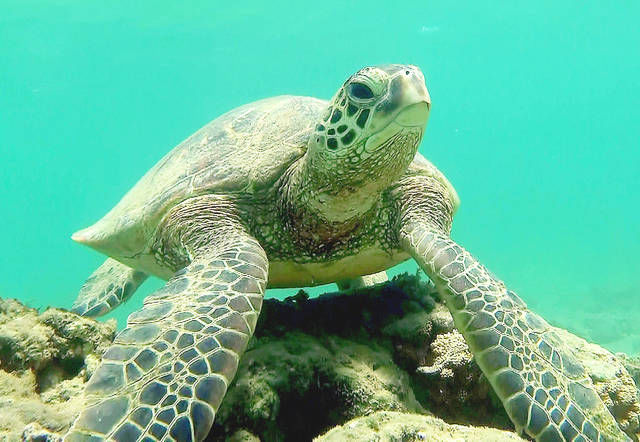LIHUE — Emilio Ruiz-Romero was driving up to Kealia Farms across the street from the beach outside of Kapaa when he saw something interesting cross the road. “I didn’t want to run it over, so I stopped. It was a
LIHUE — Emilio Ruiz-Romero was driving up to Kealia Farms across the street from the beach outside of Kapaa when he saw something interesting cross the road.
“I didn’t want to run it over, so I stopped. It was a little turtle, crossing the road to get to the stream, so I helped it,” he said. “I put it over by the water and it swam off.”
The turtle was less than a foot across in diameter, probably not a recent hatchling, but it will be joined in August and September with a new round of honu babies.
That’s because sea turtle nesting season started in May, and while most pregnant females will be migrating to the French Frigate Shoals to give birth to around 450 eggs each, some turtles are nesting in the main Hawaiian Islands.
According to archaeological evidence, historical nesting sites were spread throughout a large amount of the archipelago, but that territory was restricted over the years. Now the French Frigate Shoals is the main nesting site.
On Kauai, a handful of turtles are choosing to bury their nests in remote locations, including four or five females that generally choose Barking Sands as a nursery for their young.
“You’ll be looking for turtle tracks if you’re out on the beach in the morning. It kind of looks like a little narrow tractor came up on the beach,” said Irene Kelly, sea turtle recovery coordinator with National Oceanic and Atmospheric Administration.
Eggs will incubate in the nests for about two months before hatchlings come out, and the nesting season lasts through September.
It’s also mating season.
“You might be seeing more activity, maybe mating activity in the water,” Kelly said.
Mike Villanueva, from Wailua, said he’s seen an uptick in turtle activity on the North Shore, particularly in the Princeville area.
“When I go fishing and there’s turtles, that means there’s fish,” he said. “Go out past the resort there, and you’ll see plenty.”
Both green sea turtles and hawksbill turtles are listed as endangered or critically endangered under the federal Endangered Species Act in 1978, and since the 1970s NOAA and other partners have been researching various dynamics of the populations.
In 1973, Kelly said NOAA started counting the number of nesting females in French Frigate Shoals during the season, and in that year the number was 67.
In 2014, NOAA documented 889 nesting turtles on the eastern island where 96 percent of the green sea turtles nest.
“The population is recovering, but the nesting trend hasn’t leveled off,” Kelly said.
Females take up to 30 years to reach sexual maturity, and only nest every three or four years. When they do nest, they lay about four clutches of eggs, about 100 eggs per clutch, and bury them two feet under the sand.
“It takes time to build up those egg follicles and energy to make the 800-mile migration,” Kelly said.
Green sea turtles have been important culturally to Native Hawaiians, Polynesians and Micronesians as a food source, as well as a source of jewelry, containers and utensils, according to NOAA.
“You know, the old guys, they used to hunt them,” Villanueva said. “But I don’t think that’s good. They’re slow. There’s other things to eat out there.”
Turtles are an integral part of the ecosystem that should be respected, Villanueva said.
“They’re like the landscapers of the ocean,” he said.
In addition to overharvesting, green sea turtles are threatened by climate change and sea level rise, Kelly said.
“With sea level rise and climate change, the impacts are on low-lying lands, and the French Frigate Shoals is two feet above sea level,” she said. “It’s good the animals are laying their eggs in more baskets. It’s an evolutionary tactic to look to other places.”
Branching out presents new challenges, however, as people and turtles learn to coexist, she said.
“They’re nesting in a place with people and predators, now,” Kelly said. “It increases the challenges a little bit for management here on the main Hawaiian Islands.”
Through September, people should limit driving on the beach and bonfires, as both could destroy the eggs.
“If you put the bonfire on top of the eggs, that’s bad,” Kelly said. “Normal wear and tear, like someone sitting on a nest, we’re not worried about. But, if an army of guys walked over one, that’d be bad.”
It’s also important to give turtles their space when you encounter them, and NOAA recommends people stay 10 feet away from turtles during encounters.
“It’s a community respect thing,” Kelly said. “The community likes seeing people respecting our honu and giving them that space.”


